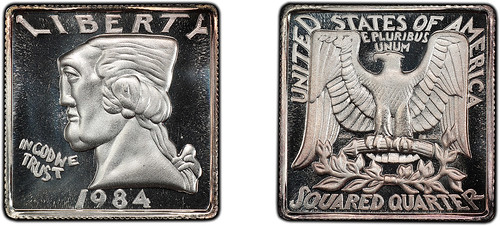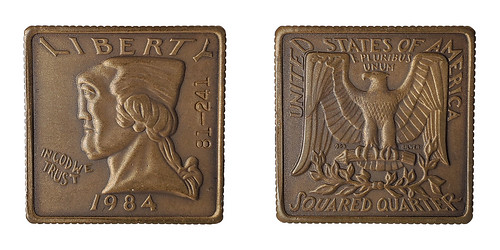
PREV ARTICLE
NEXT ARTICLE
FULL ISSUE
PREV FULL ISSUE
THE ANDOR ORAND SQUARED QUARTERJohn Thomassen wrote an excellent article on the American Numismatic Society Pocket Change blog about the squared quarter. Here's an excerpt - be sure to read the complete article online. Interesting piece. -Editor Quite often, coming across a previously unknown (to you) numismatic object can send one spiraling down a rabbit hole of investigative digging in order to uncover and learn as much as possible about said object. Such was my situation upon learning about the existence of the Squared Quarter. After seeing an image of one posted to a popular online message board, I did plenty of my own digging, and even came to learn that the American Numismatic Society has a special (and possibly unique) striking of the Squared Quarter. But first, some background: The Squared Quarter was the brainchild of artist Andor Orand (given name Andor Carius). According to the bio on his own website dedicated to the project, Andor, born in 1942, is a German-American artist who lives and works in the Princeton, New Jersey, and New York metropolitan areas. Although he works in multiple mediums—see the Princeton University Art Museum website for a few examples of his digital artwork—Mr. Orand is perhaps most well-known for his Squared Quarter project. According to a 1982 New York Times feature on the Squared Quarter, the idea to create such a piece came to Mr. Orand in 1972. He began working on the project in earnest around 1980, and the satirical "coins" were finally struck in 1982, although they all bear the date 1984. By the end of 1984, the company set up to sell the Squared Quarter—Square Deal Productions, Inc.—was officially dissolved, and in 1988 the dies, lead die trials, and sample pieces of the various versions that were struck (12 items in total) were donated to the Smithsonian, where they are archived in the National Numismatic Collection. Documentation of the donation confirms that 4 examples of the Squared Quarter were donated (one 1/4-oz. version in silver, one 1/2-oz. version in silver, one nickelsilver (cupro-nickel-zinc) version struck using the 1/4-oz. dies, and one brass version, also struck using the 1/4-oz. dies—and none in gold), as well as 4 lead trial pieces of the 1/4-oz. and 1/2-oz. sizes, and 4 disabled dies for the same sizes. Krause's Unusual World Coins, 5th ed., even lists the Squared Quarter, and gives the following mintage numbers: 300 in cupro-nickel-zinc (nickelsilver); 1,310 1/4-oz. size in .999 silver; 602 1/2-oz. size in .999 silver; 12 0.3056-oz. pieces in .999 gold; 15 in bronze; and an unknown number in brass. The gold, CuNiZn, bronze, and brass pieces extant were presumably all struck using the 1/4-oz. dies, although it is unclear if any non-silver pieces were struck using the 1/2-oz. dies, other than the lead trial pieces confirmed in the deed of gift to the Smithsonian. The impetus for designing the Squared Quarter appears to be rooted in Reagonomics. According to the artist's website, "President Reagan's attempt to bring Supply-Siders and Monetarists, two mutually exclusive economic schools, together in his fiscal policy, was seen by many observers as trying to square the circle." The project itself was also hailed a technical achievement in 1982. According to its creator, it was the first "coin" designed with the aid of a computer, and before the advent of the personal computer. Although not a pure 1:1 mapping from a circle to a square—more recent attempts using modern computers give distortions that are similar to, but not exactly the same as the Squared Quarter—a considerable amount of work still went into the translation. The booklet that came with purchased pieces explained that "a coordinate system was drawn over an enlarged photograph of a quarter, so that the X/Y values of the coin's surface points could be mapped" and then stored in a computer's memory. Afterwards, "a program was written to define the formula of the circle-to-square projection. This program instructed the plotter to produce the drawing of the Squared Quarter." This process was only used for the obverse, and was designed by computer programmer Manfred Mohr. The reverse was designed by architect and industrial designer Bill Kinsinger, who drew a square around a circle, and manually projected the points of the circle into the square, resulting in a more uniform distortion than the computer-aided obverse. The obverse and reverse renderings were then given to sculptor Harvey Citron, who made 8" × 8" plaster models, which were then handed over to the Medallic Art Company (then located in Danbury, Connecticut) to create the dies. Also noted in the 1982 New York Times feature was that the relatively sharp corners of the design, coupled with a reeded edge, presented very specific technical challenges, which required "unique tooling" according to Mr. Orand. As such, the Squared Quarter was also "the first square coin-item with sharp corners and serrated edges struck in a die with collar," as noted on the artist's website. These technical challenges required much more manual labor in the production process, as specific steps had to be conducted by hand for each piece that was struck, and this may have resulted in the low mintage figures seen, although more research is needed to confirm if the final mintage numbers deviated from the originally contracted amounts.
To read the complete article, see:
Wayne Homren, Editor The Numismatic Bibliomania Society is a non-profit organization promoting numismatic literature. See our web site at coinbooks.org. To submit items for publication in The E-Sylum, write to the Editor at this address: whomren@gmail.com To subscribe go to: https://my.binhost.com/lists/listinfo/esylum All Rights Reserved. NBS Home Page Contact the NBS webmaster 
|


